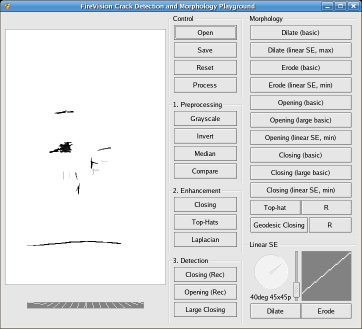Introduction
Buried infrastructures like sewers and water mains have to be checked for their current condition. Cracks are a strong indicator for the condition of a pipe. An affordable way to do detect those cracks is to take images from the pipeline and use image processing techniques to detect cracks in these images. The methods used to accomplish this task are mathematical morphology and curvature evaluation to segment images with respect to a precise geometric model to define crack-like patterns. This paper discusses a paper by Shivprakash and Iyer where this method has been proposed. It describes the method, introduces the theoretical backgrounds, discusses the evaluation of the method in the paper and evaluates the paper itself.Seminar Medical Image Processing
I participated in the seminar Medical Image Processing with this topic. Although it does not look directly related to medical applications it turns out that the method described in the paper to detect cracks in underground pipeline images works as well for blood vessel segmentation for example in retinal images. The discussed paper by Iyer and Sinha is very closely related to the paper by Zana and Klein about segmenting vessel-like structures. In fact the cracks are considered to be vessel-like and the very same approach with minor modifications is used for detecting cracks. It is in general useful to read always both papers for a full understanding since some of the definitions from the Zana and Klein paper have not made it into the Iyer and Sinha paper but they are used anyway. So you loose part of the picture if you only read the Iyer and Sinha paper.Below in the download section you find the slides and the accompanying paper of my talk which can help to give a rough introduction to mathematical morphology and the approach for crack detection proposed in the Iyer and Sinha paper.
Implementation
I wrote an application to reproduce the results mentioned in the paper (as an extra, this was not requested by the seminar) which revealed several bits of missing information in the paper. This is discussed in my evaluation. The algorithm was reproduced in the FireVision computer vision framework from the AllemaniACs RoboCup team that I'm the main developer of (no website about this, yet). For this I have used the Intel Integrated Performance Primitives library to save some time (see Used Tools section). Here are some screenshots of the application with the original crack image and the processed image. Click the screenshot for a full-size view.References
- Luc Vincent: Morphological Grayscale Reconstruction in Image Analysis: Applications and Efficient Algorithms
- Shivprakash Iyer and Sunil K. Sinha: A robust approach for automatic detection and segmentation of cracks in underground pipeline images
- Frederic Zana and Jean-Claude Klein: Segmentation of vessel-like patterns using mathematical morphologyand curvature evaluation
- David Forsyth and Jean Ponce: Computer Vision: A Modern Approach
- D. Marr and E. Hildreth: Theory of Edge Detection, Royal Society of London Proceedings Series B, Volume 207, Feb 1980, p. 187-217
- Pierre Soille: Morphologische Bildverarbeitung / Morphological Image Analysis
- Edward R. Dougherty and Roberto A. Lotufo: Hands-on Morphological Image Processing
Used tools
- LaTeX 2e (TeTex)
- Emacs
- Vi
- Xfig
- GIMP
- LaTeX Beamer
- FireVision vision framework from AllemaniACs RoboCup team
- Intel Integrated Performance Primitives
Download
This document is released and distributed under the terms of the GNU Free Documentation License (GFDL).By downloading and/or using this document you agree to this license!
| Seminar Medical Image Processing | ||||
| Accompanying paper | PostScript gzipped (2304920 Bytes) | Portable Document Format (854513 Bytes) | ||
| Slides | PostScript gzipped (10194286 Bytes) | Portable Document Format (4719833 Bytes) | ||
| Handout | PostScript gzipped (4095632 Bytes) | Portable Document Format (1713106 Bytes) | ||









